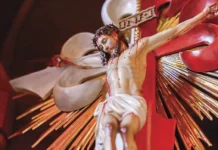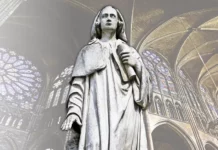Writing the words “death to the Nazarene”, the mobs displayed their outright hatred for the Church. What should our reaction be to the satanic cries that call once again for Christ’s crucifixion?
We are deeply moved to read in the Holy Gospels how, when Pontius Pilate presents Jesus to the people, he solemnly declares: “Behold your King” (Jn 19:14). But the response of the crowd gathered there – incited by the attitude of the high priests and clearly driven by demonic influence – was a unanimous cry: “Away with Him! Away with Him! Crucify Him!” (Jn 19:15).
The moment awaited by the Pharisees had arrived; they had not accepted Divine Master’s miracles, His power to drive out demons and His holy teachings, and so they plotted the death of “the Way, the Truth, and the Life” (Jn 14:6), the awaited Redeemer, the Saviour of the world.
“They took counsel how to put Him to death”
From a human perspective, the people’s attitude was incomprehensible.

Jesus had said with a kindness never before seen: “Come to Me, all who labour and are heavy laden, and I will give you rest. Take my yoke upon you, and learn from Me; for I am gentle and lowly in heart” (Mt 11:28-29). He taught with His own authority (cf. Mk 1:27) and performed such stupendous miracles that “Never was anything like this seen in Israel” (Mt 9:33).
At His entry into Jerusalem, the people had acclaimed Him: “Hosanna to the Son of David! Blessed is He who comes in the name of the Lord!” (Mt 21:9). Now, a few days later, at Pilate’s palace, the same crowd was shouting, “Crucify! Crucify Him!” (Lk 23:21). How was such a rapid change possible?
In reality, the Pharisees had long been plotting against Him. When He healed the man with the withered hand, “they took counsel against Him, how to destroy Him” (cf. Mt 12:14). On the occasion of His visit to the synagogue in Nazareth, they wanted to throw Him headlong down the mountain (cf. Lk 4:29). But the rejection reached its apex at the miracle of the resurrection of Lazarus. “So from that day on they took counsel how to put Him to death” (Jn 11:53).
The hatred of the high priests and elders was such that they wanted to kill Lazarus too, because he was proof positive of the miracle performed.
Example and message for the present
History is a “witness of the past, an example and message for the present, and a warning for the future,”1 says the famous Miguel de Cervantes in one of his works. If this is so, we can take what happened to Jesus of Nazareth as a “witness of the past” and as a useful “message for the present and warning for the future.”
Last November, we had the opportunity to comment with our readers on how the growing wave of anti-Christian acts perpetrated in the previous months represented a veritable “revolutionary anti-Christian pandemic.”2 In the weeks that followed, the shocking news of even more monstrous desecrations began to flood newspapers and social media networks. A case in point was the burning down by organized hordes of two historic churches in the city of Santiago de Chile.
The expression “organized hordes” seems contradictory, but it is in fact accurate; the videos plainly depict individuals acting in a perfectly coordinated manner. They enter and sacrilegiously destroy – note the word, which qualifies the gravity of the fact – altars, statues, pews and everything in their path.
Declaration of total hatred for the Church
Two aspects of this sinister episode of pseudo-popular rage, characterized by organized destruction, clearly demonstrate its diabolical character.

The first is the graffiti left on an altar: “Death to the Nazarene.” The second is the tragic moment when a member of that – only human? – horde, who had probably managed to climb to the choir loft from inside, stepped out of the rose window of the Church of the Assumption and kicked over a statue of the Blessed Virgin Mary, toppling it. From below rose diabolical screams.
Yes, diabolical. I repeat the word for those who have not yet realized that behind all this anti-Christian hatred is the devil himself, moving all those who open themselves to his maleficent influence. If they still doubt, let them examine the videos closely and see that, among the participants of the manifestation (which, we must clarify, may also have included thousands not in agreement with everything that happened) there were men and women dressed as demons… Without any sign of rejection on the part of those present, at least in sight.
The burned churches and destroyed statues are a “message for the present,” in the expression of Cervantes. But the phrase “death to the Nazarene” is above all a “warning for the future,” a declaration of total hatred for the Holy Catholic Church and its centuries-old teachings.
Indignation, objection and reparation
In the face of such tragic events, we cannot fail to express our deepest indignation and opposition. This is self-evident.
Firstly, because in view of such desecrations, if we are not filled with holy indignation, we shall end up like Pontius Pilate, who chose the expressive attitude of “washing his hands” when the hordes organized and incited by the Pharisees shouted: “Crucify Him!”
Indignation must be accompanied by a critical censure, a firm reprehension, and a radical execration. But this attitude of opposition is still not enough. We must complete it with an act of reparation for the sins described above and for the sacrilegious attacks that continue to be perpetrated.
This week, let us say a prayer, offer some sacrifice or fervent Communion with the aim of consoling the Redeemer during the sufferings of His Passion, which are in a sense being renewed in our days. And let us be sure to invite other Catholics to do the same.
Indignation, rejection, reparation… Failing this, we will effectively be accomplices before God and men in these terrible crimes.
May the Blessed Virgin intercede before God so that we may acquire the necessary strength to face the stormy times in which we are living. A time of confusion, persecution and anti-religious hatred, but nonetheless a time of great hopes. For this reason, we must also ask for an unshakeable confidence in the triumph promised at Fatima, however great the adversities surrounding us: “In the end, my Immaculate Heart will triumph.” ◊
Notes
1 CERVANTES SAAVEDRA, Miguel de. El ingenioso hidalgo Don Quijote de la Mancha. c.IX.
2 A New Pandemic: the Intolerance of the “Tolerant”. In: Heralds of the Gospel Magazine. Nobleton. Vol. 14. No. 157. (Nov., 2020); p.14.







